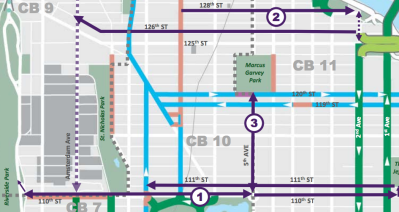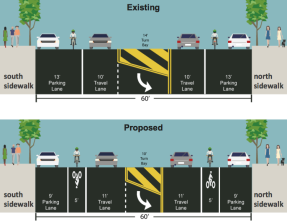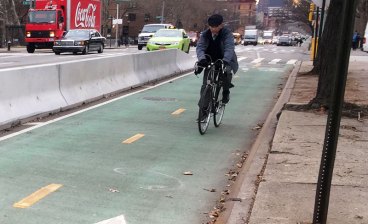DOT Proposes Protected Bike Lane for 10 Blocks of Fifth Avenue in Harlem
The project is an outgrowth of the agency's outreach for safer biking and walking access to the Harlem River bridges.

Earlier this week, DOT presented plans for a two-way protected bike lane on Fifth Avenue in Harlem, between Marcus Garvey Park and Central Park. The project would be the neighborhood’s first protected bike lane west of Second Avenue.
Agency reps presented initial concepts for Fifth Avenue, along with other Harlem-area bike improvements, to local community boards at the beginning of the summer [PDF]. The ideas grew out of DOT’s workshops for safer biking and walking access to the Harlem River bridges, as well as other surveys and outreach conducted over the past two years.
A one-way street with excessively wide motor vehicle lanes, this stretch of Fifth Avenue is prone to speeding. The DOT redesign calls for a two-way bike lane protected by parked cars on the east side of the street, which would shorten crossing distances for pedestrians by up to 25 feet.

From 120th Street to 115th Street and from 112th Street to 110th Street, the bikeway would be 10 feet wide, separated from traffic by a parking lane and painted buffer. Between 115th Street and 112th Street, alongside NYCHA’s King Towers, the bike lane would be eight feet wide, and the west curb would be converted to back-in parking.
At five of the intersections along the route, the parking lane would give with to painted pedestrian island, which would shorten the crossing distance from sixty to thirty-five feet. At 118th Street, 116th Street, and 112th Street, there would be left-turn lanes with signal phases to separate car traffic from biking and walking traffic.

To connect Fifth Avenue to the Harlem River Greenway, DOT proposes a contraflow bike lane on the block of 110th Street between Central Park and Madison Avenue, which would become an un-protected painted lane east of Madison. An un-protected bike lane on 111th would be the westbound counterpart. Another painted bike lane pair would be added on 126th Street and 128th Street.
On 110th west of Fifth Avenue, DOT is proposing painted bike lanes in both directions. In June, Manhattan Community Board 7 asked the agency to make those lanes protected.
On Tuesday, agency reps discussed the plan with the Manhattan Community Board 10 transportation committee, but the committee declined to take a position other than to needle DOT about ensuring community input, according to Transportation Alternatives Upper Manhattan organizer Dulcie Canton. Fifth Avenue is the dividing line between CB 10 and CB 11, but the bike lane itself is on the CB 11 side.
“DOT has met with both community boards and upon request we will return to Community Board 10 to present the full bike network and Community Board 11 to present additional details on the 5th Avenue Protected Bike Lane project,” an agency spokesperson said. “We hope to return to these boards this Fall.”


